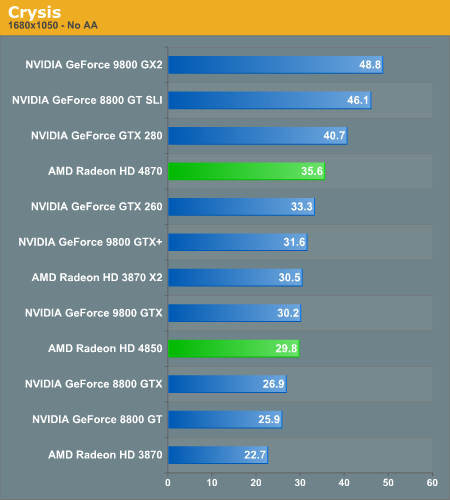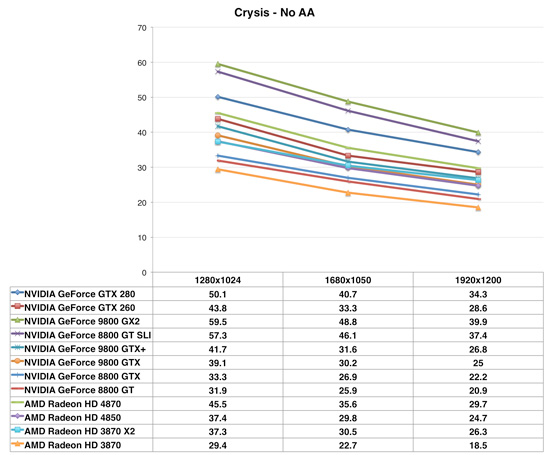The Radeon HD 4850 & 4870: AMD Wins at $199 and $299
by Anand Lal Shimpi & Derek Wilson on June 25, 2008 12:00 AM EST- Posted in
- GPUs
Crysis
Crysis is a game that can beat down all cards. We're once again using the high settings with the shaders at very high, and even at a fairly tame resolution of 1680x1050 only 8 cards manage to get past the magical 30fps rate, with nearly half of those are just squeaking by. Crysis is particularly punishing on the HD3000 series cards at these kinds of settings, where only the HD3870 X2 was competitive without resorting toCrossfire. This makes the placement of the HD4000 series all the more important.

What we see with the 4870 is very promising. Here it leapfrogs the $100 more expensive GTX 260 and delivers 7% more performance at the same time, delivering manageable framerates. It does struggle a bit to separate itself from its cheaper brother the 4850 however, with only a 20% boost in performance for a 50% boost in price. This isn't unexpected of course, it's almost exactly in line with the shader power difference between the two and we've known that this test is shader-bound for some time, but we're not seeing the memory bandwidth make even a slight difference here even at the more unplayable 1900x1200 resolution.
Neither HD4000 card can crack 30fps at higher resolutions however, after 1680x1050 you either need to turn the settings down or start throwing down additional cash for one of NVIDIA's more expensive cards or a Crossfire/SLI solution. In either case, this situation highlights the fact that on a dollar-for-dollar basis, the HD4000 series has negated NVIDIA's commanding lead with Crysis merely two weeks ago.











215 Comments
View All Comments
0g1 - Wednesday, June 25, 2008 - link
In the article it says the GT200 doesn't need to do ILP. It only has 10 threads. Each of those threads needs ILP for each of the SP's. The problem with AMD's approach is each SP has 5 units and is aimed directly at processing x,y,z,w matrix style operations. Doing purely scalar operations on AMD's SP's would be only using 1 out of the 5 units. So, if you want to get the most out of AMD's shaders, you should be doing vector calculations.DerekWilson - Wednesday, June 25, 2008 - link
The GT200 doesn't worry with ILP at all.a single thread doesn't run width wise across all execution units. instead different threads execute the exact same single scalar op on their own unique bit of data (there is only one program counter per SM for a context). this is all TLP (thread level parallelism) and not ILP.
AMD's compiler can pack multiple scalar ops into a 5-wide VLIW operation.
on purely scalar code with many independent ops in a long program, AMD can fill all their units and get close to peak performance. explicit vector instructions are not necessary.
gigahertz20 - Wednesday, June 25, 2008 - link
http://www.hardwarecanucks.com/forum/hardware-canu...">http://www.hardwarecanucks.com/forum/ha...870-512m...The site above mounted an after market cooler on it and got awesome results. Either the Thermalright HR-03 GT is just that great of a GPU cooler, or the standard heatsink/fan on the 4870 is just that horrible. Going from 82C to 43C at load and 55C to 33C at idle, just from an after market cooler is crazy! I was hoping to see some overclocking scores after they mounted the Thermalright on it, but nope :(
Matt Campbell - Wednesday, June 25, 2008 - link
The HR-03GT really is that great. Check it out: http://www.anandtech.com/casecoolingpsus/showdoc.a...">http://www.anandtech.com/casecoolingpsus/showdoc.a...Our 8800GT went from 81 deg. C to 38 deg. C at load, 52 to 32 at idle. That's also with the quietest fan on the market at low speed. And FWIW, I played through all of The Witcher (about 60 hours) with the 8800GT passively cooled in a case with only 1 120mm fan.
-Matt
Clauzii - Wednesday, June 25, 2008 - link
I see no fan on that thing??! PASSIVE?? :O ??jeffreybt2 - Wednesday, June 25, 2008 - link
"Please note that this is with a single Zalman 92MM fan operating at 1600RPM along with Arctic Cooling MX-2 applied to the base."magnusr - Wednesday, June 25, 2008 - link
Does the audio part of the card support PAP? If not all blu-ray audio will be downsampled to 16/48...NullSubroutine - Wednesday, June 25, 2008 - link
I would just like to point out that the 4870 falls behind the 3870 X2 in Oblivion while in every other game it runs circles around it. To me it appears to be a driver problem with Oblivion rather than an indication of the hardware not doing well there. Unless of course the answer lies in the ring bus of the R680?orionmgomg - Wednesday, June 25, 2008 - link
I would love to see more benchmarks with the CPU OCed to at least 4.0All the CPUs you use can hit it NP.
Also, what about at least 2 GTX 280 Cards and their numbers. Noticed that you did have them in SLI cause the power comsumption comparisons had them, but you held back the performance numbers...
Lets see the top 4 cards from ATI and Nvidia compete in dule GPU (no punt intended)on an X48 with DDR3 1600 and a FSB of 400x10!
That would be really nice for the people hoe have performance systems, but may still be rocking out a pair of EVGA 8800Ultras, cause their waiting for real numbers and performance to come out - and their still paying off theye systems lol... :]
Ilmarin - Wednesday, June 25, 2008 - link
You're probably aware of these already, but I'll mention them just in case:* Page 10 (AA comparison) is malformed with no images
* Page 21 (Power, Heat and Noise) is missing the Heat and Noise stuff.
Heat is a big issue with these 4800 cards and their reference coolers, so it would be good to see it covered in detail. My 7800 GTX used to artifact and cause crashes when it hit 79 degrees, before I replaced it with an aftermarket cooler. Apparently the 4870 hits well over 90 degrees at load, and the 4850 isn't much better. Decent aftermarket coolers (HR-03 GT, DuOrb) aren't cheap... and if that's what it takes to prevent heat problems on these cards, some people might consider buying a slower card (like a 9800 GTX+) just because it has better cooling.
Anand, you guys should do a meltdown test... pit the 9800 GTX+ against the 4850, and the 4870 against the GTX 260, all with reference coolers, in a standard air-cooled system at a typical ambient temp. Forget timedemos/benchmarks... play an intensive game like Crysis for an hour or two, and see if you encounter glitches and crashes. If the 4800 cards can somehow remain artifact/crash free at those high temps, then I'd more seriously consider buying one. Heat damage over time may also be a concern, but is hard to test for.
Sure, DAAMIT's partners will eventually put non-reference coolers on some cards, but history tells us that the majority of the market in the first few months will be stock-cooled cards, so this has got be of concern to consumers... especially early adopters.